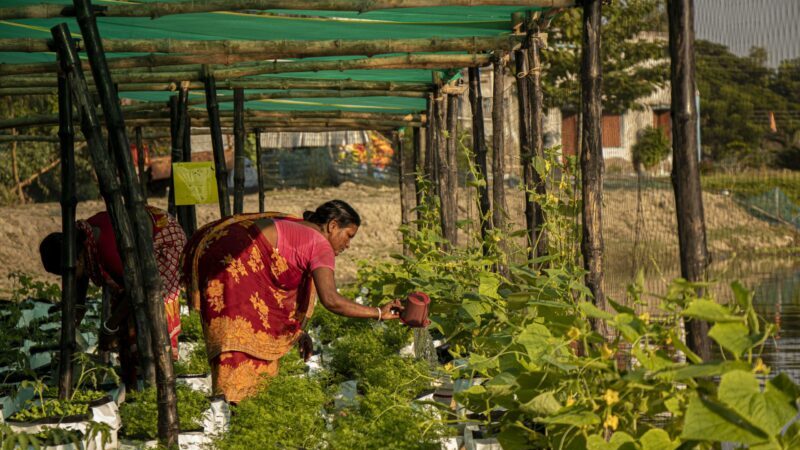Women beneficiaries of Self-Help Group (SHG) nurturing the summer crops in a float-farm in Amtoli village in the Sundarbans region of southern India and parts of Bangladesh. (Photo: South Asian Forum for Environment)
[Project Story] Floating farms are transforming life on India’s waterways
As the climate crisis unfolds it is increasingly pushing people into desperate, but inventive directions.
This fact is apparent in the Sundarban region of southern India and Bangladesh. It is a biodiverse landscape covering a vast area of swamp and mangrove. The region extends to 10,000 square kilometres where the Bay of Bengal meets the land and seeps inward through a network of winding rivers.
It is a place where people have spent generations living alongside water and the rhythm of the seasons. But the Sundarbans are now feeling the force of climate change as it faces regular extreme weather events and the devastating impacts of cyclones. The waters here are rising by an average of over 3 cm a year and storms have increased by 47% in the past decade.
Floating farms
The huge amounts of water coming off the bay during these cyclones deposit an equal amount of salt onto farmland and in groundwater, destroying crops and putting clean drinking supplies at risk. Increased extreme weather is forcing communities into greater conflict with natural wildlife – in an area with a sizeable population of tigers – and leading to greater urban migration. In response, communities are looking at new ways to protect their livelihood and the environment they depend on.
Conventional farming methods in the region are chemically intensive, harm nature and remain at the mercy of rising sea levels. One innovative project is instead seeking to work with the water, lifting farms onto floating platforms which support sustainability and restore community life.
A trial of floating farms is run by the South Asian nature Forum for Environment (SAFE), supported by the Adaptation Fund. Funded by the Adaptation Fund Climate Innovation Accelerator (AFCIA), the initiative is part of the first round of AFCIA grants financed by the Fund and administered by the UN Development Programme. The project involves 12 local villages and 2,200 households, which in turn support thousands in the wider agrarian economy.
Ranjan Mandal, the head of Amtoli village council, said that: “After Amphan and Yaas (super cyclones), three quarters of the village was under saltwater. We had lost all hope but were provided for by SAFE’s innovative adaptation. It is unique that on a bamboo float raft, we can grow all vegetables for both self-consumption and sale, as well as saving the seeds for the next crop cycle. This is very much locally made and well-framed to survive the storms. Our farmers can make it (the floats) themselves and we can use it for multiple purposes.”
Continue reading the full original article on Climate Home News.



